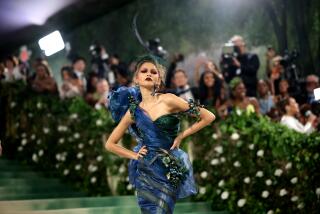MUSIC REVIEW : Bokser Compositions at Newport Museum
Of the four pieces that composer Zelman Bokser had planned to demonstrate his stylistic versatility Friday night, two required last-minute personnel substitutions. This could have spelled disaster, but the program--part of the Contemporary Culture Series at the Newport Harbor Art Museum--emerged vibrant and multifaceted.
Members of the California E.A.R. Unit stepped in to replace the originally scheduled Aquaelis Ensemble, which had already surmounted the problems of Three Studies for cello and percussion but was prevented from this appearance by an injury to one of its players. Cellist Erika Duke and percussionist Amy Knoles delivered the work with security.
Bokser described the 1983 composition as “the first piece that I wrote that explores, to any great degree, (the percussion family). . . . A study in the relationship between a pitched instrument and a series of non-pitched instruments.” The complement of percussion, he told the audience, “evolves” from movement to movement.
The set begins with a loud solo on tom-tom and gong which, with the addition of wood block, is subdued to provide accompaniment for a high cello solo. This aching melody is punctuated by ominous rumblings and finally, quietly sealed by the gong.
Percussion plays an increasingly dominant role as the work progresses. In the second movement, gongs, cymbals and bowed crotales often lead a sometimes frenetic, sometimes eerie cello line.
The third movement highlights pitched percussion--especially the strange sounding crotales, which was imitated by the cellist as she began her tortured solo. The longest study, it develops in a series of climaxes and releases, defying concentration by obscuring formal focus, to concentrate interest in a rainbow of timbres.
Bokser’s piano trio, “Behind the Gathering Clouds,” was performed by the Viklarbo Ensemble, with cellist David Shamban substituting for the ailing Sebastian Toettcher. The three movements depict “an external, physical storm; an internal, psychological storm, and (the clearing) after the storm,” Bokser told Friday’s audience. Violinist Maria Newman, pianist Wendy Prober and Shamban tackled the work with passion and flair.
Bokser astutely programmed his trio as the entire second half of the concert. The most recently composed (1989) and on first hearing the most successful, this is a sure pleaser, a powerful virtuosic vehicle that owes much to late-Romantic Angst.
“Earth Winds” (1983), an otherworldly piece in which individual lines blend almost imperceptibly into one another, received effective treatment in the hands of the Debussy Trio--flutist Angela Schmidt, violist Keith Greene and harpist Marcia Dickstein.
Clarinetist Janna Hall strutted her instrument’s stuff in a fussy Caprice for solo clarinet (1984).
More to Read
The biggest entertainment stories
Get our big stories about Hollywood, film, television, music, arts, culture and more right in your inbox as soon as they publish.
You may occasionally receive promotional content from the Los Angeles Times.






